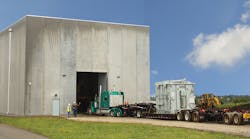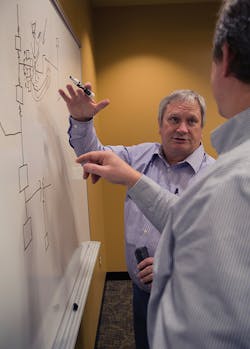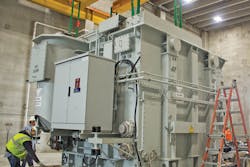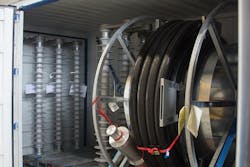The world has changed drastically, and today’s power grid has changed along with it. America’s dependence on power has never been greater and its concerns of grid security never higher. Headlines state the threats — both from nature and humans — that could cripple the grid: 9/11, the Pacific Gas and Electric Co. Metcalf incident, electromagnetic interference, cyber threats and more. Utilities are increasingly faced not only with delivering reliable service, but also anticipating and addressing potential threats to the nation’s power supply.
Efforts in recent years — including the U.S. Department of Energy’s transformer study, the Quadrennial Energy Review task force and the Fixing America’s Surface Transportation (FAST) Act — highlight a need to modernize the nation’s transmission system, the intense focus on building resilience into critical infrastructure and the concern surrounding the availability of large transformers. The performance and availability of high-voltage transformers is especially critical. When a high-voltage transformer fails, it weakens the system. Backup transformers can be difficult to locate, take weeks to deliver and months to deploy, and take a year or longer to replace.
Only the nation’s largest utilities can maintain an economically advantaged fleet of unique spares. For most utilities, locating, acquiring and moving a large backup transformer is costly and time consuming. During the time it takes to replace a traditional transformer, while relying on sometimes less than robust backup conditions, the grid is not as strong as it could be. The delicate balance of cost and need to ensure reliability — even in unforeseen circumstances — is a common thread among electric utilities. Aware of new-world threats and aiming at improving the security and resiliency of its infrastructure, Westar Energy took the initiative to enhance grid security through an innovative approach.
Swiss Army Knife Solution
Like many in the industry, Westar Energy has made increased grid security and resiliency integral to providing reliable, clean and affordable electricity. It has been said national security is a function of grid security. Thus, there are many reasons to enhance the resiliency and reliability of the electric power grid.
As the largest electric utility in Kansas, Westar Energy’s operational footprint spans great distances among various power supplies — notably, remote wind farms, large substations and load centers. A key member of the Southwest Power Pool, the utility operates 6400 miles (10,300 km) of transmission lines, servicing one of the continent’s largest concentrations of renewable energy in rural areas of Kansas.
Because Westar Energy is a mid-sized utility, its economical backup options are limited but critical, and the utility relies heavily on its high-voltage transformers to move power across and through its asymmetrically vast grid. Previously, the utility could only provide a backup transformer by maintaining costly unique spares or by borrowing one from another location, a less-than-ideal solution.
As the power grid ages, innovative ways are being found to address wear and tear as well as modernize industry infrastructure. When essential transformers fail, the system is vulnerable. Westar Energy engineers were not satisfied with the usual transformer solutions, which included waiting months for a replacement or investing in several multimillion-dollar replacements to keep on standby. Instead, the utility’s engineers imagined a rapid-recovery solution that would be faster and vastly more flexible than had ever been developed.
The result was the development of a groundbreaking concept for a flexible, multi-tap, high-voltage transformer that could be optimally located, easily transported and rapidly deployed to any of Westar Energy’s key substations — in essence, a Swiss Army knife of high-voltage transformers. An innovative concept, the world’s first mobile resilience, adjustable-voltage transformer can be transported on a trailer by an ordinary semi-truck and can provide 80% coverage of critical transformers on the utility’s transmission system, returning the grid to security in days instead of weeks or months.
Robust Recovery
It is the inherent nature of engineers to imagine smarter, better ways of doing their jobs as well as improving processes and equipment. Westar Energy’s leadership encourages its engineers to dream big and ask what-if and why-not questions.
With years of experience and firsthand knowledge of service challenges and field operations, the engineers on this project first created a list of must haves for a transformer that could replace a large percentage of the transformers on the utility’s high-voltage power grid, and do so within days instead of weeks or months. The mobile transformer’s weight and dimensions would need to be optimized for easy, quick transport and deployment. Flexible components would be needed as well as multi-tap voltage options adaptable to virtually any high-voltage substation on the utility’s system. While others had developed solutions with some of these components, none had developed this first-of-its-kind solution incorporating all of them.
The engineers also needed a creative partner to execute the concept and used an innovative approach in their search for a manufacturer. Rather than restrict vendors’ thoughts with a particular model or specific diagrams, they instead issued a request for information, providing only their criteria and functional requirements. After all, what they were seeking was, as yet, an engineering unicorn.
For most potential partners, it was too much of a risk to go out on an experimental limb to create equipment that did not fit their molds and to start from scratch with only ideas to build something that did not yet exist. The partner they sought would need to be bold and also have the desire and wherewithal to innovate. Out of a dozen manufacturers, they received responses from two.
One manufacturer, Siemens, grasped the potential, saw an opportunity based on the industry’s growing need for more resilient infrastructure and enthusiastically accepted the challenge. In the spring of 2014, Westar Energy began work with Siemens on this first-ever multi-high-voltage mobile transformer with plug-in cables and 345-kV bushings.
Developing the first of anything can be quite exciting, but it is always challenging. Using the concept, Siemens and Westar Energy were driven by the challenge. The teams met several times at Siemens’ flagship plant in Austria and numerous times by phone. It was a calculated risk, but it had to work. There was some doubt and fear as well as excitement during the process. At times, the team asked, “What have we started?” Other times, they thought it would never work. Eventually, along the way, the project gained more proponents than naysayers.
Size Counts
Employing creative thinking, the team overcame its largest, seemingly insurmountable foe — the size of the unit. To accomplish the imagined solution, the unit could not require specialized heavy haulers, road closures or a railroad for transport and delivery. A novel bushing design ultimately saved the day.
Early in the process, the bushing design created the most prominent light-bulb moment. The socket design and plug-in capability enables the silicone-shielded bushings to be installed or removed without the necessity of pulling down the transformer oil level, draining the tank, or opening the transformer and having personnel enter the tank to make the connection. This enabled the team to reduce the installation time, the oil handling and the unit’s dimensions greatly without compromising functionality. Additionally, forced-oil cooling equipment is used.
Designing additional components in a new way, the team reduced the weight from approximately 600,000 lb (272,155 kg) for a traditional transformer to three units, each weighing in at less than one-fourth of that. As a result, each unit meets standard shipping dimensions for over-the-road transport using standard tractor-trailers, like those used for moving common pieces of large construction equipment.
Versatile Features
Achieving its goal of a truly mobile solution, the team successfully completed factory testing in January 2016, introducing a one-size-fits-all spare transformer with the following features:
• Multiple low-side and high-side taps to maximize applicability
• Modular accessories
• Self-contained station power
• A modular, preinstalled cooling system
• Quick-disconnect control cables using a common control cabinet
• Optimally located, secure, F5 tornado-rated permanent storage.
With all the features needed to make it versatile, the unit also had to be robust. The unit has standard connections for several voltage levels — including 345 kV, 230 kV, 138 kV or 115 kV — with a secondary connection possible through bushing to an overhead bus or a plug-in cable connection, increasing flexibility in adjusting voltage. It also is transported fluid filled, which increases installation ease and enables the unit to be connected to the grid anywhere on the Westar Energy system within a few days.
The final product, delivered just two years later in May 2016, has had a tremendous impact on Westar Energy and on the entire North American power grid. For Westar Energy, the mobile unit can temporarily replace any one of 80% of its large transformers, ensuring the integrity of the utility’s grid and the power flow to its customers.
Recently, Westar Energy experienced a large 345/115-kV transmission autotransformer failure. In response, the rapid-recovery transformer was deployed and placed in service on June 9. It was installed in nine days, working only normal daylight shifts. Had crews worked round the clock, the installation time could have been reduced by half.
Comprehensive Recovery
While increasing its overall reliability with the adjustable-voltage mobile transformer, Westar Energy seized the opportunity to build on its recovery planning and ensure its critical backup was immune to all types of threats, from weather to weapons.
The mobile transformer is a significant improvement in resiliency and includes security features that protect it — and the grid — from damage or failure, including the following:
• Enables Westar Energy to react quickly to unforeseen events
• Includes bullet-resistant bushings
• Can be filled with ester instead of mineral oil for improved environmental and fire safety
• Is housed in a highly secure storage facility.
Given the critical purpose of the new transformer, Westar Energy expanded its recovery efforts to include the storage and deployment of the unit, safeguarding the investment when not in use and being prepared for service, thus creating another first of its kind in the industry. Close to major highways in an undisclosed location, the transformer’s home base is a purpose-designed structure that provides the following capabilities and components:
• Ability to withstand weather conditions, including wind speeds up to 250 mph (402 kmph)
• Full inside access for semi-trucks
• An indoor crane to readily load and unload the components while still protected
• Housing for standardized instructions and component storage, which enables personnel to test and prep the unit for service easily and systematically
• 14-inch (355-mm)-thick walls that can withstand gunshots
• 24/7 protection by security measures that include monitored cameras.
As an industry priority, the security of the electric grid requires investment in infrastructure and technology that is smarter, more dynamic, flexible and secure. A complete resilience strategy minimizes risks to infrastructure, safeguards equipment to protect against failure, and includes a recovery plan that enables a utility to respond as quickly and safely as possible.
By designing protected storage and a standardized deployment — along with its new mobile resilience transformer — Westar Energy helped to set the stage for utilities around the world to create more comprehensive recovery planning and keep power flowing.
Pioneering Recovery
The development of mobile resilience, adjustable-voltage transformers enhances grid security and reliability for large utilities everywhere. The modularity and flexibility of the system enhances its applicability across different substation configurations, which means faster recovery, greater resilience and more redundancy — with lower investment. This innovation enables utilities to respond quickly to unforeseen events and prevent strain or frailty, protecting critical assets from harm and increasing grid security. It also fulfills key North American Electric Reliability Corporation (NERC) resiliency requirements for utilities to access quickly equipment critical to maintaining a stable power grid.
With Siemens now making the mobile resilience transformer available, other utilities worldwide — first among them, Consolidated Edison — have stepped up to use it to enhance the robustness and resilience of their systems. ♦
Chris Marshall is manager of substation physical design at Westar Energy. He joined the utility 18 years ago and led work to establish standardization in Westar Energy’s substations as well as develop and implement systems to keep substation documentation current. Creating consistency in documentation has helped to ensure craft and engineering staff members are working from the same information and results in a more efficient, safer workplace. Marshall holds a BSEE degree.
Doug Venjohn started at Westar Energy 34 years ago as a relay technician and now serves as manager of transmission and substation predictive maintenance. Frequently, he has worked on special projects such as designing an automated communication system to check substation systems using nightly calls from modems, because fiber was not yet an option. He also has worked with coauthor Chris Marshall when critical large transformers have failed and quick response is needed to maintain the stability of the transmission system until repairs or replacements can be made. Venjohn earned his associate’s degree in electronics.
Top 10 Facts About Westar Energy’s Rapid-Recovery Transformer:
1. Was the world’s first such transformer
2. Concept created by Westar Energy and further developed with Siemens
3. Designed to be adaptable for use in multiple locations
4. Engineered to work at a range between 115 kV and 345 kV, enabling it to replace more than 80% of the transformers on Westar Energy’s high-voltage power grid
5. Transported on trailers by standard semi-trucks
6. Adapts to road rules and accessibility versus the heavier 250-ton transformers it replaces
7. Eliminates the use of railroad and special heavy-duty hauling trucks
8. Requires fewer transport permits and costs
9. Greatly reduces the time to deploy a replacement from 30 days to 60 days to plan, permit and complete to within 7 days to 10 days
10. Contains bullet-resistant components and is housed in a highly secure facility







